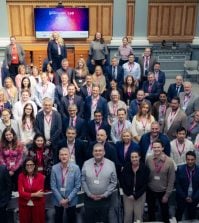‘Work is an activity, not a place’: how governments are responding to the hybrid working era

The era of flexible working means that the offices public servants work in need to change. Global Government Forum brought together property experts from governments in Canada, the UK, and Ireland to discuss what changes are needed – and how they will monitor what works
The coronavirus pandemic catalysed many profound changes to how governments work. Among them was the widespread move to working from home for public and civil servants. Even as countries have emerged from lockdowns, large numbers of employees want to continue working remotely – and many public sector organisations have embraced changes to enable their staff to have a better work-life balance.
So, we have moved to an era of hybrid working, where people work from offices some of the time, and at home the rest of the time.
This means that what public sector offices are for – and how they look – needs to be rethought. The old requirement for rows of desks has changed. Now, offices need collaboration spaces for officials to work together when they are in the office – and the technology to enable people to dial into meetings when they are not.
To find out how governments are grappling with the moves to flexible and hybrid working, Global Government Forum brought together a panel of senior public servants from around the world to share their developing ideas and good practice.
Here, we set out some of the main points from the conversation, with the relevant clips from the webinar.
Stephan Déry, the assistant deputy minister for real property services in Public Services and Procurement Canada, highlighted what he called a “strategic opportunity” for the Canadian government to offer flexible workplaces to its employees.
“A key aspect of this offering is fit-for-purpose office space that is green, accessible, inclusive, and modern with functional layout, and the latest technology,” Déry said.
“In this future-of-work vision employees can either be working in an office or teleworking from anywhere they can be productive. Work is an activity, not a place, and that’s what is intended to support new ways of working.”
The Government of Canada is now planning to modernise 71 of its office complexes over the next five years to “really make them ready for the future of work”, with offices becoming a magnet for employees to come in when they need to.
“I believe that offices will always be part of the mix, it’s a question of what do we need offices for,” Déry said. “Less and less people will go to sit at a workstation and do work eight hours a day, but the office becomes the hub where you collaborate, where you create, where you build a sense of community and you care for one another. And I think that’s what the office of the future will be.”
Kate Guthrie, the deputy director of workplace experience and smarter working programme director at the UK’s Government Property Agency (GPA), highlighted many similarities with Déry’s points. “The whole world really is facing this subject and these issues,” she said.
She spoke about how the UK government wanted to make the office a “magnet” for workers, as opposed to mandating that people return.
“Our offices still aren’t as full as we want them to be, and we want people to be using them for the right reasons [and] one of the ways that we’re doing this is through smarter working.”
The UK government introduced its smarter working programme in 2018. It also had other modernisation schemes before this, which had not had lasting impact.
“What we wanted to achieve through the smarter working programme was a real difference – enabling people across the civil service to work in the right place, given the activity that they’re delivering, in order to best deliver their personal, team and organisational objectives,” Guthrie explained.
As a result, the transition at the start of the COVID-19 pandemic to working from home was probably smoother for the departments that had already adopted smarter working.
Now, the GPA is collecting data on what employees want from remote working. Staff have begun to highlight the activities that are best done at home, and those that are best done in the office.
“You can see here things like learning from others, social interaction and hosting visitors are much better supported within our offices than they are at home, but the list of activities that are actually better supported at home are quite long.
“What we hope over time is that by investing in our property and providing really fantastic places to work, that we’ll see a bit of a switch there that will see a balance, you know, more activities will be better supported in our offices than at home.”
The data gathered by GPA also reveals a shift in the number of days people want to work in the office, from four to five pre-COVID to two days a week now.
“This is all really helping us to shape our design, our strategy and our ways of working,” Guthrie said. “We have got the four C’s [of priorities for the office]: collaboration, community, creativity and caring.
“We think people need a real purpose to go into the office [and] these are the four things that we believe in. And you could add a fifth one, connection, I guess, but perhaps if you’re doing all of these other four, then connection will come naturally. These are the things that we’re really promoting as the use of our offices.”
Martin Bourke, commissioner and head of estate management, Office of Public Works, Ireland, echoed much of what had been discussed by the previous speakers.
“It is amazing the similarities between what everybody is doing and what everybody is grappling with.” There were no “magic bullets”, he said, and there was a quick pace of change and decision-making required around hybrid working.
“We’re not starting from a blank canvas,” he said. “There are limits to resources, and therefore we have to tailor everybody’s expectations as to what’s possible.”
Bourke was speaking from experience of working to rationalise the public sector estate after the 2008 financial crisis. “That required the Office of Public Works and the Irish civil service to accelerate its thinking in terms of utilisation of space, because we had to rationalise our portfolio dramatically.
“We had to shed quite a lot of office space, and that was all done primarily through breaking out of leases. That rationalisation was a real jolt.”
This got the Irish government on the “starting blocks” around office utilisation and space before the COVID pandemic hit.
But alongside the physical changes being made to workplaces, there is what Bourke called “the human journey” alongside that. “We have no doubt that staff have embraced hybrid working, that’s unquestionable,” he said. “But how well equipped are managers for that? The human element of management, the tools for management has been leapfrogged over [by the prevalence of hybrid work] and we need to catch up.”
Andy Holdsworth, the head of group property at the UK’s Department for Transport, agreed that there are “still an awful lot of unanswered questions” about the future of the office.
“The challenges, I think, are fairly clear and fairly fixed,” he said. “It’s when we get to delivery and outputs that there’s a lot of questions.”
Picking up on Bourke’s comments about the management challenge, Holdsworth highlighted that challenges include that the Department for Transport and arm’s-length bodies have different HR policies, and that there was a need to review the technology available in offices to reflect the era of Zoom and Teams.
“I don’t think the traditional flat screen on the wall type arrangement is necessarily good enough nowadays for that,” he said.
He also highlighted the need for government to respond to challenges such as sustainability, to which he said the best approach was to reduce floorspace first and foremost, which also tied into the expectation in the UK that departments will have to make cost savings and efficiencies.
Reflecting on what other speakers had said around what the office would become post-COVID, Holdsworth said that he personally started off thinking the office would end up being a social environment, a collaboration environment, and a place for people to come to interact.
“I think that’s probably where it really should be going. But my observations recently are that it’s not like, and what we’ve got is people coming into the office and having to get on with their normal day’s work, which means they have to spend maybe three, four or five hours in video calls, and therefore we have to enable that.
“So the ‘new normal’ for me hasn’t yet got anywhere like the office being a social and collaboration environment, it is certainly an environment where we’ve got to cater for everyone’s requirements in the hybrid world.”
Dean Smith, the joint managing director (UK & Europe), WT Partnership, an independent international consultancy practice, pointed to what he called the “building blocks” of flexible working and encouraging staff back into the office.
Drawing on a question from the audience, Smith asked “why do we need necessarily to encourage people back into the office? The answer is, well, we don’t need to fully bring people back into the office. It shouldn’t be done for the sake of it, it shouldn’t be done because that’s the way it’s always been done. It should be because there are real benefits such as mentoring and recognising that, fundamentally, we are actually social animals and we do thrive in that sort of environment. And it’s long been known that working as a team working collaboratively creates far better outcomes than individuals working in isolation.
“That’s why the importance of a hybrid model and alternative model needs to be considered. But it should absolutely be focused on what the value and the benefit is for the respective organisation. We shouldn’t be, in my opinion, slavish to saying people should be in ‘X’ number of days a week. It should be appropriate for the task that those individuals perform.”
The idea of having task-based spaces was around before COVID, Smith said, but it needs to be revisited, and in the hybrid working era “it is important for people to have the confidence if they’re going to travel into an office space, that that there is going to be a space available for them”, he added.
“If you’ve condensed the portfolio down, people are going to want to have the reassurance that when they get in, there is going to be a desk, or a room, or booth available for them to use for whatever they need to do in that particular day.”
“It’s not about an office anymore, it is about creating a hub where there is real value of people coming together, and there is the ‘magnet’, as has been referred to, to actually draw people in, because they see the value and the worth of doing so. And we’ve got to consider that whatever we decide now is part of an evolution.”
In questions from the audience, the panel also discussed how they would monitor the effectiveness of new flexible working arrangements.
To learn all this and more, you can watch the full Buildings for the future – reworking the public service office for the flexible working era webinar. The webinar – hosted by Global Government Forum with the support of knowledge partner WT Partnership – was held on 10 November 2022.




















